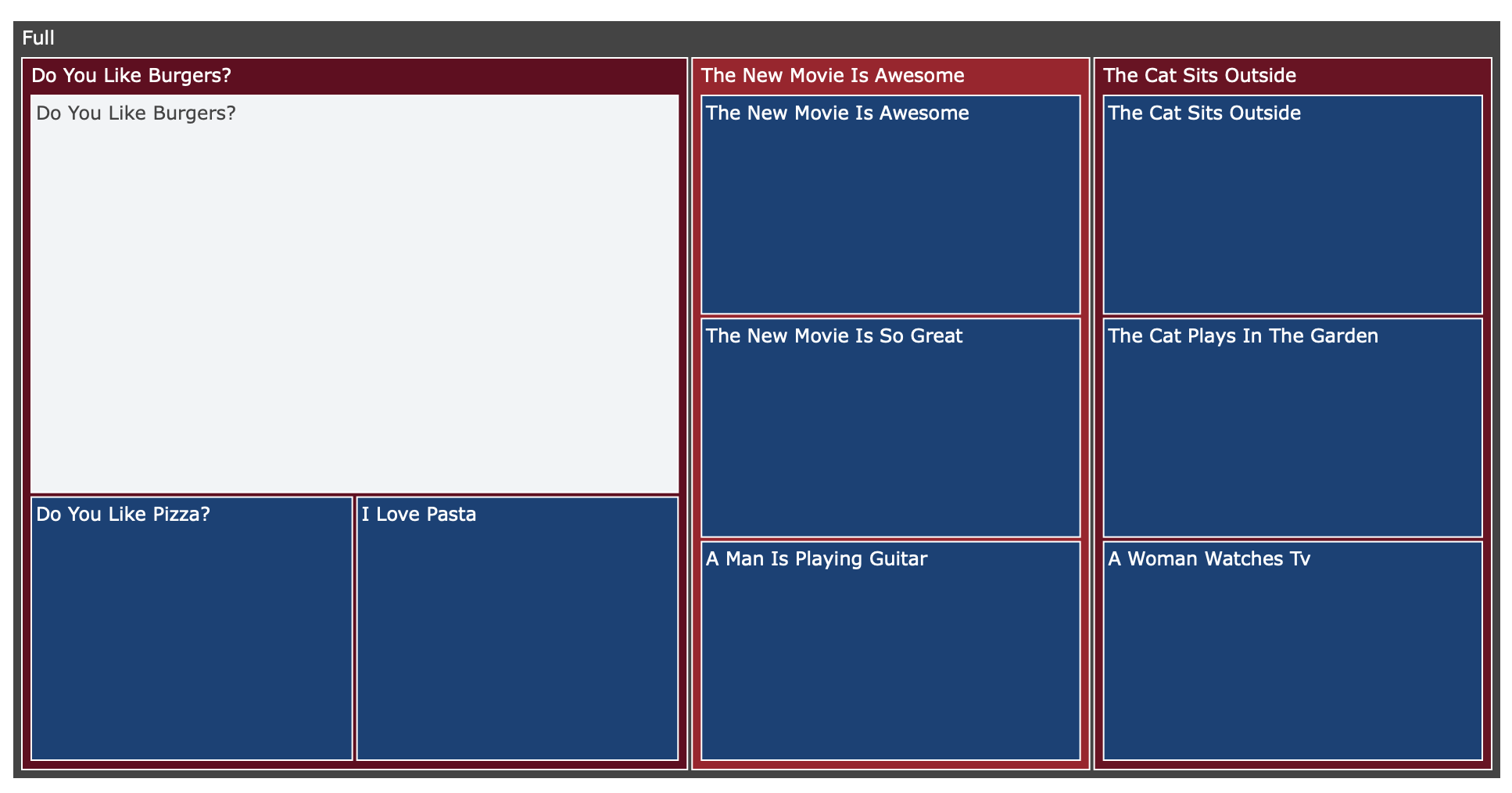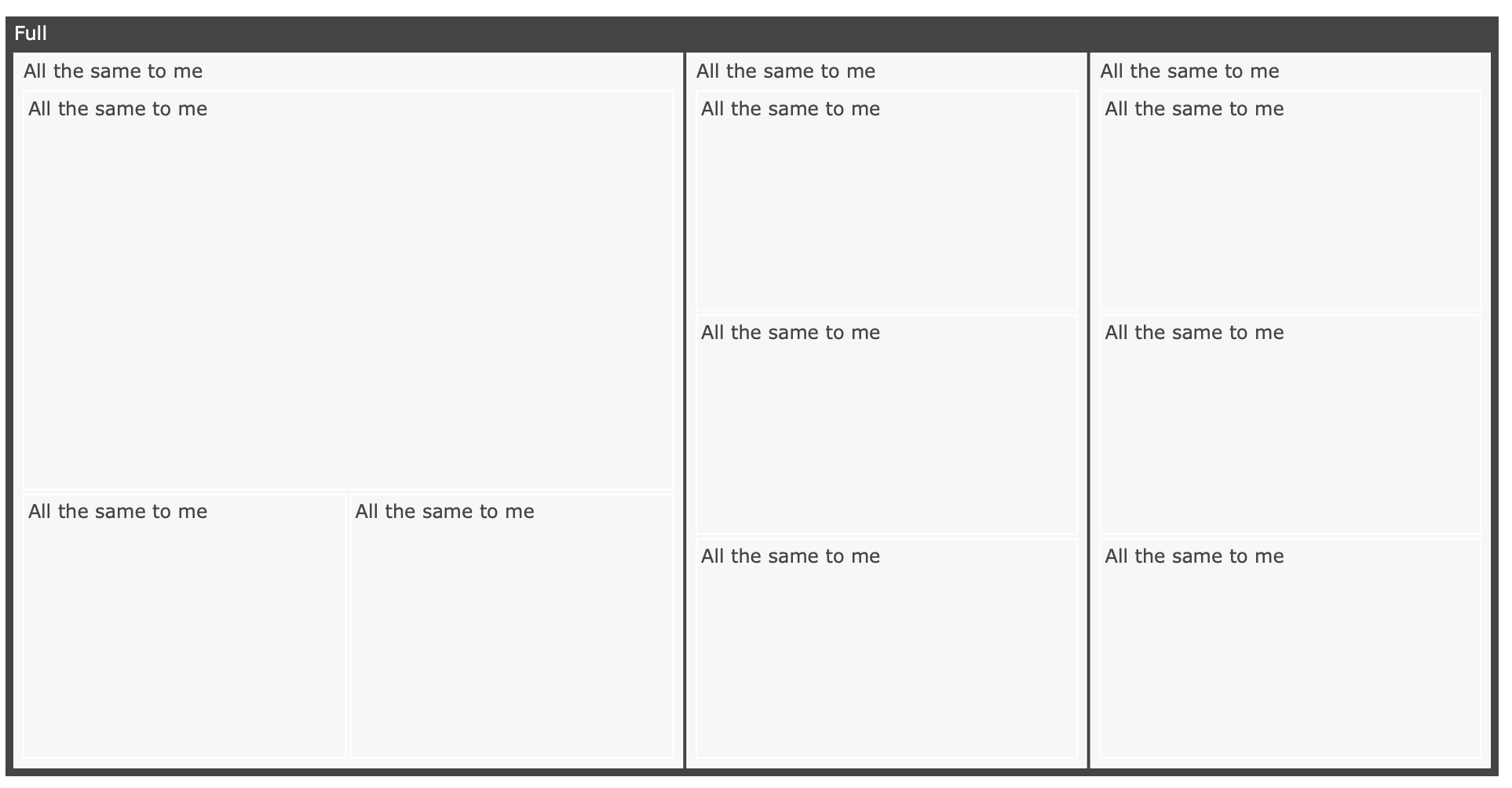PictureText converts a list of short documents to an interactive tree map with minimal code. It defaults to SBERT for text representation, leverages Hierarchical Agglomerative Clustering (HAC) for grouping and tree maps to visualize text interactively.
Given a corpus of short documents (think news headlines) it can group them into hierarchical groups, that semantically belong together. It also allows the reader to explore each group in more detail by going deeper into a hierarchy and dynamically pulling out of it when needed.
The approach is intended for grouping large sets of non-domain specific short texts. For instance: news headlines, natural language questions and social media posts would be good candidates.
conda create --name pt python=3.6
conda install -n pt nb_conda_kernels
conda activate pt
pip install picture_textConsider the default values and their result
txt=['The cat sits outside',
'A man is playing guitar',
'I love pasta',
'The new movie is awesome',
'The cat plays in the garden',
'A woman watches TV',
'The new movie is so great',
'Do you like pizza?',
'Burgers are my favorite',
'I like chips',
'I will have french fries with my burger'
]
from picture_text.picture_text import PictureText
# initializing just sets the text corpus
pt = PictureText(txt)
# Calling the method does the heavy lifting:
# 1. HAC
# 2. text embedding
pt()
# This step puts it all together:
# 1. converts HAC into a treemap format
# 2. determines a summary for each cluster and
# 3. draws & return a treemap
pt.make_picture() Checkout the blogpost for more explanation or Colab notebook for interactive examples
The pipeline works as follows:
- Perform any required preprocessing to get to a list of document strings
- Embed / Encode all documents with the method of choice, defaults to SBERT
- Use HAC to get a “linkage” table of hierarchical assignments of each point to the rest of the data. Uses fastcluster, ward linkage by default.
- Convert to layers for treemap. Iteratively create “layers” by selecting a set number of splits to each layer to satisfy the format needed in treemaps
- Summarize. Generate a summary for each layer. In the default setting, uses the observation closest to the average of the cluster. Using the average of the cluster to represent its centroid is used in a number of few-shot, unsupervised settings
- Draw treemap. Use plotly's treemap for interactive visualization
Consider the default values and their result
from picture_text.picture_text import PictureText
pt = PictureText(txt)
pt(hac_method='ward', hac_metric='euclidean')
pt.make_picture(layer_depth = 6,
layer_min_size = 0.1,
layer_max_extension = 1,
treemap_average_score = None,
treemap_maxdepth=3,)Changing layer_depth parameter sets the number of layers produced by the split.
pt.make_picture(layer_depth = 1)Changing layer_min_size parameters determines what is the minimal acceptable size of a new cluster for each layer. By default layer_min_size is 0.1 (or 10%) meaning if a layer has a cluster smaller than 10% we will try to find another cluster to add to the layer hoping that the next one will be bigger. We will do so up to increasing the relative number of additional clusters up to 1 (or 100%, layer_max_extension = 1). Increasing both of these significantly basically means that we get a lot more clusters a lot earlier.
pt.make_picture(layer_depth = 1,
layer_min_size = 0.9,
layer_max_extension = 3,
)The defaults are the following
pt = PictureText(txt)
pt(hac_method='ward', hac_metric='euclidean')However, those get fed directly into fastcluster, hence all choices from the fastcluster documentation are available here too.
The key features to this sort of approach are the embeddings as well as the method of multi-doc summarization. You can use your NLP tools of choice there.
The default set of text embeddings is via SBERT's distilbert-base-nli-stsb-mean-tokens.
from picture_text.picture_text import sbert_encoder
pt = PictureText(txt)
pt(encoder=sbert_encoder)However, any mapping of a list of text to encoding can be used instead.
def silly_encoder(text_list):
return [[1]]*len(text_list)
pt(encoder=silly_encoder)
pt.make_picture()The default summary method is to take the cluster member closest to the cluster average. However, any mapping of a list of texts and embeddings into a text summary can be used instead.
def silly_summarizer(txt,txt_embeddings):
return "All the same to me", 0
pt.make_picture(summarizer = silly_summarizer,)





